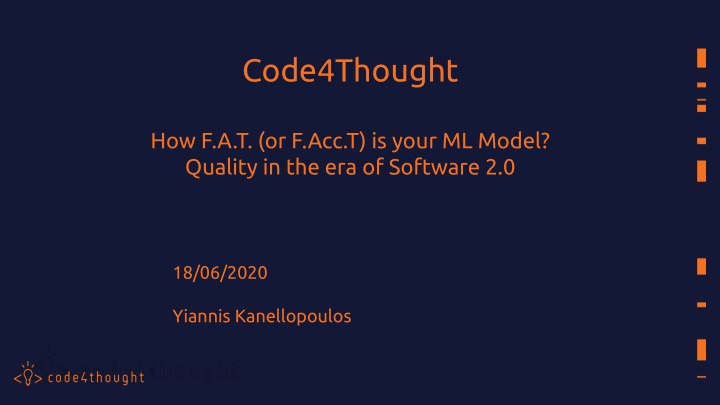



Code4Thought How F.A.T. (or F.Acc.T) is your ML Model? Quality in the era of Software 2.0 Test 18/06/2020 Yiannis Kanellopoulos
Technology as part of history Test
What keeps us at night ● Our team has spent the better part of two decades analyzing and evaluating Test large scale software systems in order to help corporations address any potential risks and flaws related to them. By doing so we realised that the produced technology is the mirror of its ● organisation. ● At Code4Thought, we’re turning all this expertise into a technology that will ensure AI/ML models are: ○ Fair, ○ Accountable, ○ Transparent.
The software types Test Deterministic (Code Driven) Probabilistic (Data Driven)
Code-driven vs Data-driven Test How many IF statements would you need for implementing and most importantly maintaining such tree?
From Software Quality to AI Behavior Test Code-Driven Data-Driven ⎷ X Existence of Industry Standards and Certifications ⎷ Formal Training and Professional Certifications - ⎷ Methodologies, Tooling, Processes - ⎷ Regulations, Legal Requirements - Χ Doesn’t exist ⎷ Fully exist - Partially exist
Challenges for a successful AI/ML implementation ● Choosing the right solution (i.e. suitable model, algorithm) for a given business problem, ● Creating proper training datasets (e.g. lack of labels, classes misrepresentation) for the models at hand, ● Lack of trust to a model’s results upon deployment.
Challenges for building Trust ● Technical teams strive for accuracy and fast delivery and not so much for building trust. ● Accountability or Fairness are merely afterthoughts, ● When trust is imposed as a regulatory requirement (e.g. transparency) ad-hoc and one-off solutions are implemented.
Building Trust: (How to) use the F.A.T properties ● Be Simple but not simplistic, ● Be Transparent but selective, ● Use references/standards/check-lists.
F.A.T. checks as part of a ML pipeline Test
Fairness Analysis: Check for Bias Test Target One metric as a key indicator (or KPI). The rest can provide additional information/insights. Demo: https://dashboard.code4thought.eu
Fairness Analysis: Provide insights in perspective Test Target
Accountability Evaluation: Organisations + Models Test Algorithmic Systems Accountability Models Organisations (Cater for) (Designed, Implemented and Evaluated for) Responsibility/Human Involvement Algorithmic Presence Explainability Data Accuracy Algorithm Input Auditability Performance Evaluation Fairness Inferencing
Accountability Evaluation*: The value of checklists Not priorities Test No annotations Unsupervised model *Yiannis Kanellopoulos, “Accountability of Algorithmic Systems: How We Can Control What We Can’t Exactly Measure” https://www.cutter.com/offer/accountability-algorithmic-systems-how-we-can-control-what-we-can’t-exactly-measure Cutter Business Technology Journal, March 2019. ** Helen Tagiou, Yiannis Kanellopoulos, Christos Makris, Christos Aridas, “A tool supported framework for the Assessment of Algorithmic Accountability”, in International Conference on Information, Intelligence, Systems and Applications (IISA) , July 2019.
Transparency Methods *: Open up the black box Test Contrastives Feature Importance Demo: https://xai.code4thought.eu * A. Messalas, Y. Kanellopoulos, C. Makris, “ Model-Agnostic Interpretability with Shapley values,” in International Conference on Information, Intelligence, Systems and Applications (IISA) , July 2019
Transparency as (additional) means for identify Bias False prediction as a female
Stay in touch Test ● See: xai.code4thought.eu, dashboard.code4thought.eu Contact: yiannis@code4thought.eu ● ● Follow: @code4thought.eu
Client Testimonial Test “Analyzing our cloud-based, AI-infused analytics service, as well as our data science practices, with Code4Thought was a thought-provoking experience. The improvement areas we have identified, through the concise questionnaire and illuminating visualizations of the internals of our algorithms, increased our confidence on the robustness of our product and maturity of our organization and processes. Indispensable!” Distinguished engineer at US company, specializing at secure digital workspaces 18
Authority is increasingly expressed algorithmically Test “Already today, ‘truth’ is defined by the top results of the Google search.” Yuval Noah Harari, “21 lessons for the 21st century”
Chris Material Test ● “ Avoid proliferation of measures. A new measure for fairness should only be introduced if it behaves fundamentally differently from existing metrics. Our study indicates that a combination of class-sensitive error rates and either Disparate Impact Ratio or CV is a good minimal working set.” A comparative study of fairness-enhancing interventions in machine learning, arXiv:1802.04422 ● Adult data set. The other protected attribute is 'sex' ('Male' is privileged and 'Female' is unprivileged). The outcome variable is 'annual-income': '>50K' (favorable) or '<=50K' (unfavorable). (See next slide)
Test
Test Target
The “four-fifths rule” “a selection rate for any race, sex, or ethnic group which is less than four-fifths (4/5) (or 80%) of the rate for the group with the highest rate will generally be regarded by the Federal enforcement agencies as evidence of adverse impact ” EEOC Uniform Guidelines on Employee Selection Procedures, 29 C.F.R. § 1607.4(D) (2018).
Examples of Legally recognized sensitive attributes • Race ( USA: Civil Rights Act of 1964, EU : Council Directive 2000/43/EC of 29 June 2000 ) • Sex ( USA : Equal Pay Act of 1963; Civil Rights Act of 1964, EU : European Convention on Human Rights Article 14) • Age ( USA : Age Discrimination in Employment Act of 1967, EU : Council Directive 2000/78/EC) • Religion, Color ( USA : Civil Rights Act of 1964, EU : Treaty of Amsterdam Article 13) • Familial Status ( USA : Civil Rights Act of 1968 Title VIII, EU : Equality Act 2010) • Disability Status ( USA : Rehabilitation Act of 1973 and Americans with Disabilities Act of 1990, EU : Equality Act 2010) • …
Recent Headlines
Recommend
More recommend